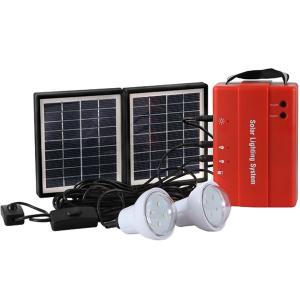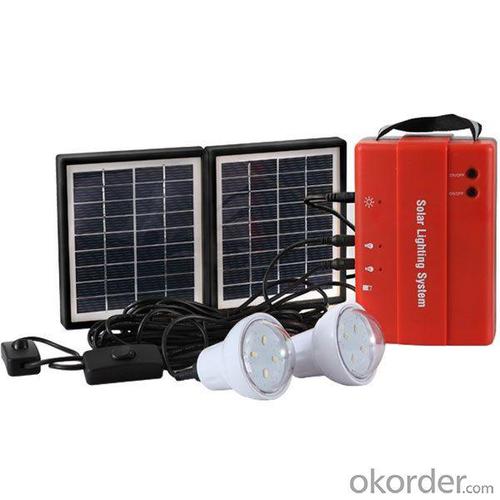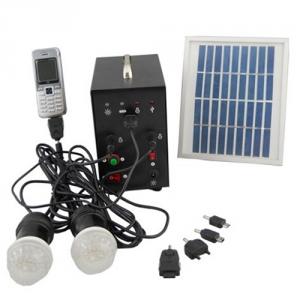Sun Tec Solar Energy Systems 3.4w Solar Lighting System with Mobile Charge LED Bulb Light Outdoor 3.4w Solar Panel 4500mAh Battery CE
- Loading Port:
- Shenzhen
- Payment Terms:
- TT/LC
- Min Order Qty:
- 100Sets set
- Supply Capability:
- 20000 SETS Per Month set/month
OKorder Service Pledge
OKorder Financial Service
You Might Also Like
This 3.4w 9v solar panel solar lighting system with mobile charge 4500mAH 6v and 2 led globe bulbs. This portable solar energy system can generate power for 2 LED bulbs, it can work 15 to 30 hours every day.
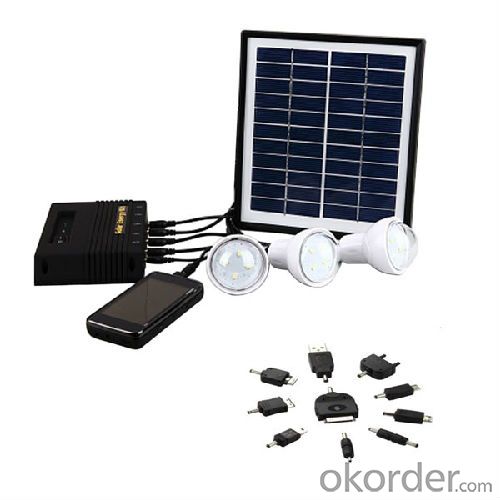
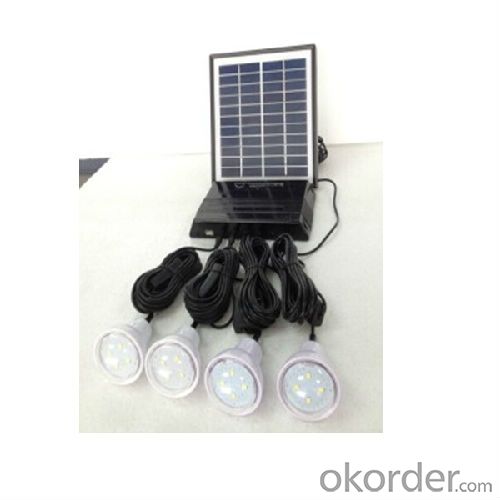

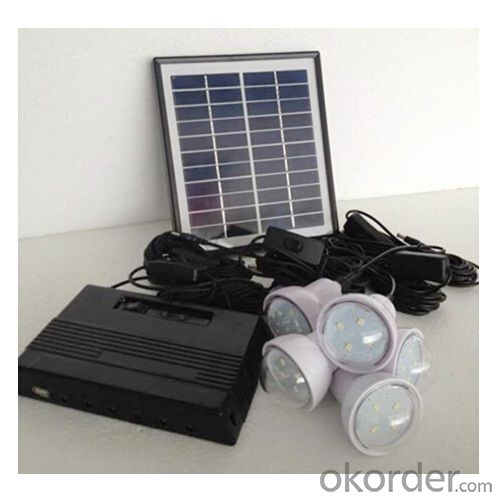
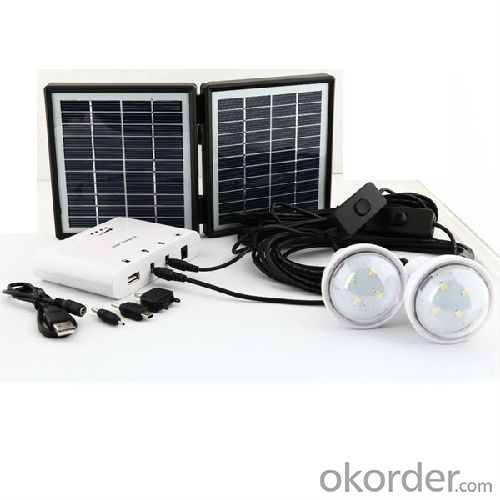
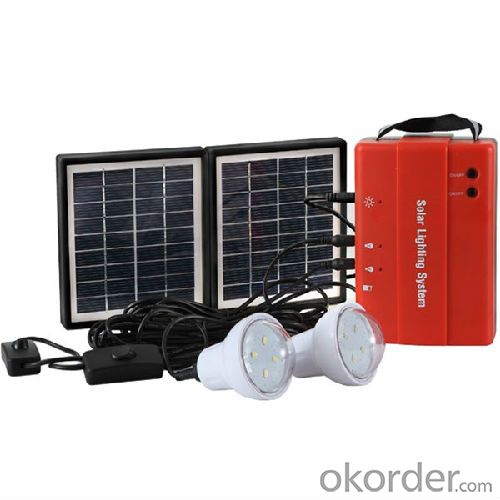
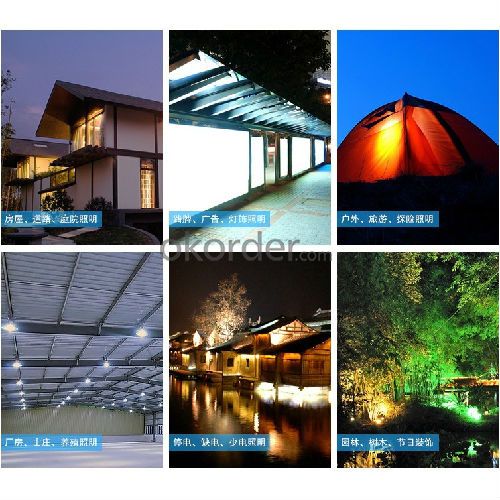
Parameter
1, Rechargeable by solar or AC adaptor;
2 With 10 in 1 USB mobile phone charger
3. Housing material: ABS;
4. Battery: 4.5AH/6V maintenance free Lead-acid ;
5. Lighting time: 30 hours after fully charged; 10hrs after one day charge by sun.
6. Accessory: two bulbs with 5M long cable(with switch on the cable)
7.Over charge and over discharge protection.
| Application: Home |
| Output Voltage (V): 9V |
| Load Power (W): Depends |
| Solar Power (W): 3.4W |
| Work Time (h): 15-30hours |
| Solar Panel: 9V 1.7W *2pcs |
| Battery type: 6V 4.5AH Lead-acid battery |
| Material: ABS |
| Usage: indoor home lighting & outdoor lighting |
| Light source: 0.9W 90lumens |
| Color: red |
| Optional charging: 8V AC adaptor |
| IP level of solar panel and bulb: IP65 |
| IP level of control box: IP44 |
| USB output: 5V 500MA |
Feature
1, Foldable solar panels
2, With 10 in 1 USB phone charger and 2pcs of LED bulbs
3, CE
Usage/Applications
Rural homes, campers, fishermen, outdoor campaigns or activities, etc. Remote area, mountainous area, desert area, grassland area,
Village, country area, Camping, outdoor activities, travel, Lighting at night.
Customized options
1. OEM/ODM available;
2. It's also available to customize your own solar lighting systems, solar lanterns, or any solar lighitng products by giving us solar lights picture / 3D draft / technical datas.
Packing & Delivery
Package:
1* solar panel
1* portable system box
2* LED bulbs with on/off button on cable
inner box size: 190*140*170mm
12pcs/carton
carton size: 580*305*355mm
Delivery:
|
Shipping Service |
Estimated Delivery Time |
|
DHL |
2-8 business days |
|
FedEx |
3-8 business days |
|
TNT |
2-10 business days |
|
UPS |
1-7 business days |
|
EMS |
6-14 business days |
|
ePacket |
7-12 business days |
|
China Post Air Mail |
7-15 business days |
|
China Post SAL |
14-30 business days |
|
Air freight |
3-10 business days |
|
By Sea |
30-40 business days |
1. 3-5 business days for Sample Orders; 7-30 business days for Bulk Orders for Bulk Orders.
2. "Business days" means Monday-Friday, excluding holidays.
3. DHL and UPS cannot ship to military or P.O. boxes address
4. The Shipping Service above is for reference only, for any other questions, please feel free to contact us.
Factory
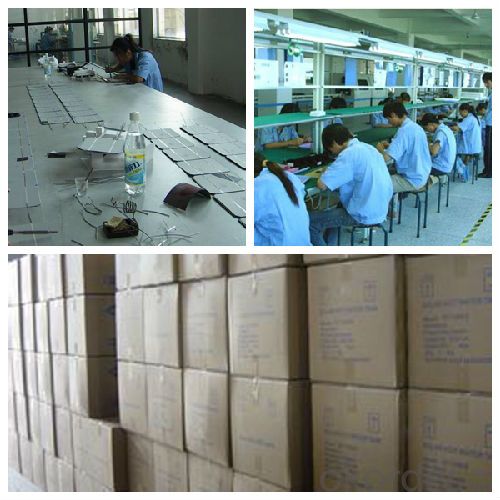
- Q: Can a solar energy system be used in areas with high humidity?
- Indeed, areas with high humidity can make use of a solar energy system. Although high humidity can have an impact on the functionality of a solar energy system to some degree, contemporary solar panels are engineered to endure diverse weather conditions, including high humidity. While the efficiency of solar panels may slightly decline in the presence of high humidity due to the moisture in the air, it is not a substantial factor that would render solar energy systems inefficient. Moreover, adequately maintaining and cleaning the panels can alleviate any possible problems caused by humidity. In conclusion, areas with high humidity can still effectively employ solar energy systems.
- Q: Can solar energy systems be used for outdoor lighting?
- Yes, solar energy systems can be used for outdoor lighting. Solar-powered outdoor lighting systems use solar panels to capture sunlight and convert it into electricity, which is stored in batteries. This stored energy is then used to power outdoor lights during the night. Solar-powered outdoor lighting is a sustainable and cost-effective solution that eliminates the need for traditional electrical wiring and reduces carbon emissions.
- Q: Can solar energy systems be integrated with battery storage?
- Yes, solar energy systems can be integrated with battery storage. Battery storage allows excess solar energy generated during the day to be stored for use during times when the sun is not shining, such as at night or during cloudy weather. This integration enhances the reliability and efficiency of solar energy systems by providing a continuous and reliable source of electricity.
- Q: Can solar energy systems be used to heat water?
- Yes, solar energy systems can be used to heat water through the use of solar thermal collectors or solar water heaters. These systems absorb sunlight and convert it into heat, which is then used to warm the water for various purposes such as domestic use, swimming pools, or even industrial processes.
- Q: Can solar energy systems be used in areas with limited access to solar energy training programs?
- Yes, solar energy systems can be used in areas with limited access to solar energy training programs. While training programs can be beneficial in helping individuals understand how to design, install, and maintain solar energy systems, there are various resources available that can still enable people to harness solar energy even without formal training. Online resources, books, and manuals can provide valuable information on solar energy systems, and local experts or organizations can offer guidance and support. Additionally, some solar energy companies may offer on-the-job training or apprenticeship programs to help individuals acquire the necessary skills. Ultimately, with determination and resourcefulness, individuals in areas with limited access to training programs can still utilize solar energy systems effectively.
- Q: Can solar energy systems be used in powering sports stadiums?
- Certainly, sports stadiums can be powered by solar energy systems. In fact, numerous stadiums worldwide have already begun implementing solar energy systems to fulfill their energy requirements. To harness sunlight and convert it into electricity, solar panels can be installed on stadium rooftops, parking lots, or open areas. The primary benefit of utilizing solar energy to power sports stadiums is its sustainability and cost-effectiveness. Solar energy is a renewable energy source that doesn't emit any greenhouse gases during operation, making it environmentally friendly and assisting in reducing carbon footprint. Additionally, once the initial investment is made to install solar panels, the ongoing operational costs are relatively low, resulting in significant energy bill savings for the stadium. The size and structure of sports stadiums make them excellent candidates for solar energy systems. The stadiums' expansive surface areas provide ample space for installing a substantial number of solar panels, which can generate a significant amount of electricity. Furthermore, the open spaces surrounding the stadium allow for optimal sunlight exposure, ensuring maximum energy generation. Moreover, solar energy systems can be integrated with other technologies to enhance efficiency and functionality. For example, battery storage systems can be utilized to store excess energy generated during the day and use it during nighttime events or periods of low sunlight. This ensures a continuous and reliable power supply to the stadium, regardless of weather conditions or the time of day. In conclusion, solar energy systems can certainly be employed to power sports stadiums. They offer a sustainable and cost-effective solution to meet the energy requirements of these large facilities while also reducing their environmental impact. With further advancements in solar technology and decreasing costs, it is expected that more sports stadiums worldwide will embrace solar energy as their primary power source in the future.
- Q: How do solar energy systems affect the installation of satellite dishes?
- Solar energy systems can potentially impact the installation of satellite dishes by obstructing the line of sight between the satellite and the dish. This obstruction can cause signal interference or loss, affecting the satellite dish's performance. However, with proper planning and positioning of both the solar panels and the dish, it is possible to minimize any potential conflicts and ensure optimal functioning of both systems.
- Q: Can a solar energy system be installed in a historic building?
- Yes, a solar energy system can be installed in a historic building. However, there may be certain challenges and considerations that need to be addressed. The main concern when installing solar panels on a historic building is the preservation of its architectural and aesthetic integrity. The installation should be carefully planned and executed to minimize any visual impact on the building. This may involve integrating the solar panels into the existing structure or finding discreet locations for their placement. Another consideration is the structural integrity of the building. Historic buildings often have unique construction methods and materials that need to be taken into account when installing solar panels. A structural analysis may be necessary to ensure that the building can support the additional weight of the panels. Additionally, the electrical infrastructure of the building may need to be upgraded to accommodate the solar energy system. This may involve rewiring or installing additional equipment, which should be done in a way that does not compromise the historic fabric of the building. Finally, it is important to consult with local authorities and preservation organizations to ensure compliance with any regulations or guidelines regarding the installation of solar panels on historic buildings. They may have specific requirements or recommendations that need to be followed to safeguard the building's historic significance. With careful planning, consultation, and consideration of the unique characteristics of the historic building, it is possible to install a solar energy system that can provide renewable energy while preserving the historical integrity of the structure.
- Q: How do solar energy systems impact property values?
- Solar energy systems can have a positive impact on property values. Studies have shown that homes equipped with solar panels tend to sell for higher prices and at a faster rate compared to those without solar systems. This is primarily due to the cost-saving benefits of solar energy, as it reduces utility bills and increases energy efficiency. Additionally, solar-powered homes are often perceived as more environmentally friendly and sustainable, which appeals to eco-conscious buyers.
- Q: I usually have to use about 10 degrees, more in the summer! Winter sunshine time 10 hours! Who knows how much a set price, what brand?
- Sold to the power supply bureau 0.45 yuan once, the state subsidy fee of $0.42, a year issued 3000 kwh.
1. Manufacturer Overview
| Location | |
| Year Established | |
| Annual Output Value | |
| Main Markets | |
| Company Certifications |
2. Manufacturer Certificates
| a) Certification Name | |
| Range | |
| Reference | |
| Validity Period |
3. Manufacturer Capability
| a) Trade Capacity | |
| Nearest Port | |
| Export Percentage | |
| No.of Employees in Trade Department | |
| Language Spoken: | |
| b) Factory Information | |
| Factory Size: | |
| No. of Production Lines | |
| Contract Manufacturing | |
| Product Price Range | |
Send your message to us
Sun Tec Solar Energy Systems 3.4w Solar Lighting System with Mobile Charge LED Bulb Light Outdoor 3.4w Solar Panel 4500mAh Battery CE
- Loading Port:
- Shenzhen
- Payment Terms:
- TT/LC
- Min Order Qty:
- 100Sets set
- Supply Capability:
- 20000 SETS Per Month set/month
OKorder Service Pledge
OKorder Financial Service
Similar products
Hot products
Hot Searches
Related keywords
